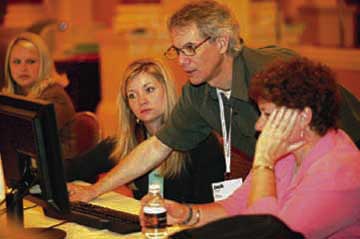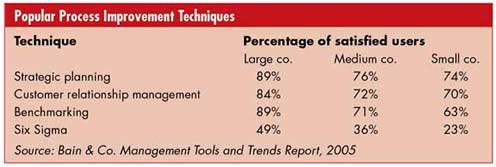2006 Baldrige Winners Announced



2006 Baldrige winners, top to bottom: Premier Inc., North Mississippi Medical Center and MESA Products Inc.
|
Three organizations--a manufacturing company, a hospital and a health care alliance--recently received the 2006 Malcolm Baldrige National Quality Award.
The winners are MESA Products Inc., Premier Inc. and North Mississippi Medical Center.
The winners were announced by President Bush and Commerce Secretary Carlos Gutierrez. They were selected from 76 applicants after a rigorous year-long evaluation process that examined the organizations' leadership; strategic planning; customer and market focus; measurement, analysis and knowledge management; human resource focus; process management; and results.
MESA Products, a recipient in the small-business category, designs and manufactures cathodic protection systems that control the corrosion of metal surfaces. Based in Tulsa, Oklahoma, MESA achieved a sales increase from less than $6 million in 1985 to more than $25 million in 2006. It has applied lean manufacturing concepts to dramatically improve cycle times. After the application of lean at MESA, output in the company's instrumentation equipment assembly area increased by 60 percent, lead time for the sales order entry process was reduced by 30 percent and error
rates were cut in half. The company also enjoys employee-satisfaction rates that are 20 percent or more above industry norms.
Premier, a recipient of the Baldrige Award in the service category, is a strategic alliance that is owned by 200 nonprofit hospitals and health system organizations. Owners share services and programs aimed at improving clinical quality and cost effectiveness. With annual revenues of $500 million, Premier has 932 employees who are located across the United States. Premier has emphasized the promotion of best practices in ethical conduct, transparency and accountability in health care organizations. Its pre-tax operating income increased from approximately $140 million in 2002 to $223 million in 2006, and its operating margin increased from 35 percent in 2003 to 50
percent in 2006. Premier's customer-perceived value has improved, too; retention of hospital members increased from 94 percent in 2002 to 97 percent in 2006. Savings and cash returns to Premier's hospital owners--due to process improvement projects--increased from $180 million in 2002 to $804 million in 2006.
North Mississippi Medical Center serves 24 rural counties and is the largest rural hospital in the country. It provided community services to 156,750 people in 2006, and it gives free access to an electronic medical record to every caregiver in its system. This provides current medical information for patients wherever they are, and helps reduce medical errors and duplication of effort. In 2006, physician overall satisfaction surpassed the medical center's benchmark by 9 percent, with overall satisfaction and ease-of-practice scores of 99 percent. The medical center's leadership scored 98 percent on the survey.
"President Bush and I applaud the three 2006 recipients of the prestigious Baldrige Award," says Gutierrez. "With their innovative practices, commitment to excellence and outstanding results, these organizations are among America's best, and are role models for any organization striving for world-class performance."
For more, visit www.nist.gov.
Do the Math
Last month's "Do the Math" got a tremendous response. Almost every entry detected the main problem with the following statement, which is widely disseminated on the Internet and even, for a while, on an Environmental Protection Agency Web site: "One gram of mercury can contaminate a 20-acre lake."
The problem lies with the phrase "20-acre lake." Contamination is based on volume--so many parts per million of contaminant per liter (or gallon, or any other volumetric measurement). An "acre" is a measurement of surface area, not volume, and so the statement makes no sense.
Several readers investigated the source of this statement and discovered that it may have been a misinterpretation or inappropriate extrapolation of a study released by Ed Swain, Ph.D., of the Minnesota Pollution Control Agency. In the article "Increasing Rates of Atmospheric Mercury Deposition in Midcontinental North America," in the Aug. 7, 1992, issue of Science magazine, Swain noted that the annual deposition of atmospheric mercury is 12.5 mg of mercury per square meter, or 1 gram for approximately 20 acres. The study was done by measuring the sediment in seven Minnesota lakes, hence the lake connection. Nowhere does Swain discuss whether this is a toxic amount of mercury.
Congratulations to Jose Merced, randomly selected from all correct entries to win an incredible (and cheap) prize from Quality Digest.
For next month's "Do the Math," based on the EPA's maximum contaminant level guidelines for mercury in drinking water, what would the average depth of a 20-acre lake have to be for one gram of mercury dispersed in that lake to exceed the EPA's safe drinking levels? Send us your answer by clicking the feedback link at the bottom of this page.
Size Matters
When it comes to quality, size counts. A comprehensive study by Bain & Co. found that the size of an organization affects how it manages its internal processes. According to the research, 49 percent of large companies (those with more than $2 billion in annual corporate sales) have Six Sigma programs; 36 percent of medium companies (with $600 million to $2 billion in corporate sales) and 23 percent of small companies (those with less than $600 million in annual corporate sales) use the methodology.
Six Sigma isn't the most popular business improvement technique on the market, though. Bain & Co. found that the top three improvement and management approaches are strategic planning, customer relationship management and benchmarking.
For more information, visit www.bain.com/management_tools/about_overview.asp?groupCode=1.

Perry? Is That You?
File this under strange news: An Indian "registrar" recently made an attempt to steal the professional identity of Perry Johnson Registrars Inc.
The company, which was reportedly operated out of Calcutta, India, used the name Parry Jhonson Registrars Inc. The fraudulent company also apparently cloned Perry Johnson Registrars' Web site, changing only the spelling of the company's name, and included the legitimate logos of Perry Johnson Registrars' accreditation bodies as its own.
"I've never seen anything like this before," says Lori Kirkconnell, Perry Johnson Registrars' director of accreditation. "I can't imagine how this guy thought he could get away with this. It's just amazing that he had the gall to
do this."
Kirkconnell is not sure how long the fraudulent Web site was operational or if the company issued any certificates. She doubts that it did, however, noting that she would have expected to hear from disgruntled clients after their notification that their certificates were fraudulent. Perry Johnson Registrars has extensive operations in India and was informed of the imposter company's existence by a client who found it online. The site was taken down less than 24 hours after the company complained to its accreditation bodies, and has since all but disappeared. The company couldn't be reached for comment.
"Who knows where he is now," says Kirkconnell. "As long as he doesn't try anything like this again, I really don't care where he is."
For more information, visit www.pjr.com.
Leaving a Legacy
A new book encourages executives to consider their careers as opportunities to leave legacies for their companies and the broader world.
In Your Leadership Legacy: Why Looking Toward the Future Will Make You a Better Leader Today (Harvard Business School Press, 2006), Robert Galford and Regina Maruca demonstrate the importance of "legacy thinking" to leadership development and show why and how leaders should consider their legacies on their way into a leadership position, as opposed to when they're nearing the end of their careers. Legacy thinking, observe the authors, ensures that leaders' personal and organizational priorities are reflected in their actions, and frames those actions so that all stakeholders are satisfied.
"Our central idea is that one's desired leadership legacy should be a catalyst for action rather than a result considered after the fact," say Galford and Maruca. "As best we can tell, you only have one chance in this world, so it's important not to waste it."
Galford is a managing partner of the Center for Executive Development, and Maruca is a principal at the organization. For more information, visit www.yourleadershiplegacy.com.
 ISO 9001 Revision: Coming Soon ISO 9001 Revision: Coming Soon
The quality world won't be waiting much longer for the much-anticipated release of a revised ISO 9001.
ISO/TC 176, the technical committee that's been developing the revision for several years, met in South Korea Nov. 13–18 and agreed that the revised version of the standard will be released in early 2007. It's expected to include no new requirements for registration and to focus only on clarifications of the standard's current requirements. The committee will also release a revised version of ISO 9004.
TC 176 will next meet in June to discuss early public comments to the revised standards and release second drafts of the documents later in the year.
For more information, visit www.iso.org.
Starrett to Be
Profiled on TV
The L.S. Starrett Co. will be the focus of an episode of a series on the Travel Channel this month.
The network's Made in America series focuses on U.S. manufacturing companies with long histories of producing high-quality, world-renowned products. Starrett was chosen based on its 127-year toolmaking history and reputation for careful craftsmanship. Starrett is the last remaining full-line American precision tool company that still manufacturers, sells and services its products domestically and worldwide.
Made in America is hosted by John Ratzenberger, who played Cliff Clavin in the long-running television series Cheers . He is a former carpenter who owns a Starrett square, and tried his hand at toolmaking during the filming of the episode at Starrett's Athol, Massachusetts, headquarters.
"I've always thought of machinists as artists," says Ratzenberger. "When you're working with tolerances of one ten-thousandths of an inch, if you make a mistake on a piece, you have to throw it away. Leonardo De Vinci could paint over his mistakes, and everyone knows who he is. It's my job to make the world aware that these are
true artists."
The episode is scheduled to air beginning Jan. 9 at 9 p.m. EST on the Travel Channel. It will most likely, as with other Made in America episodes, air on other dates during the month as well. For more information, visit http://travel.discovery.com/fansites/jrmia/jrmia.html.
|